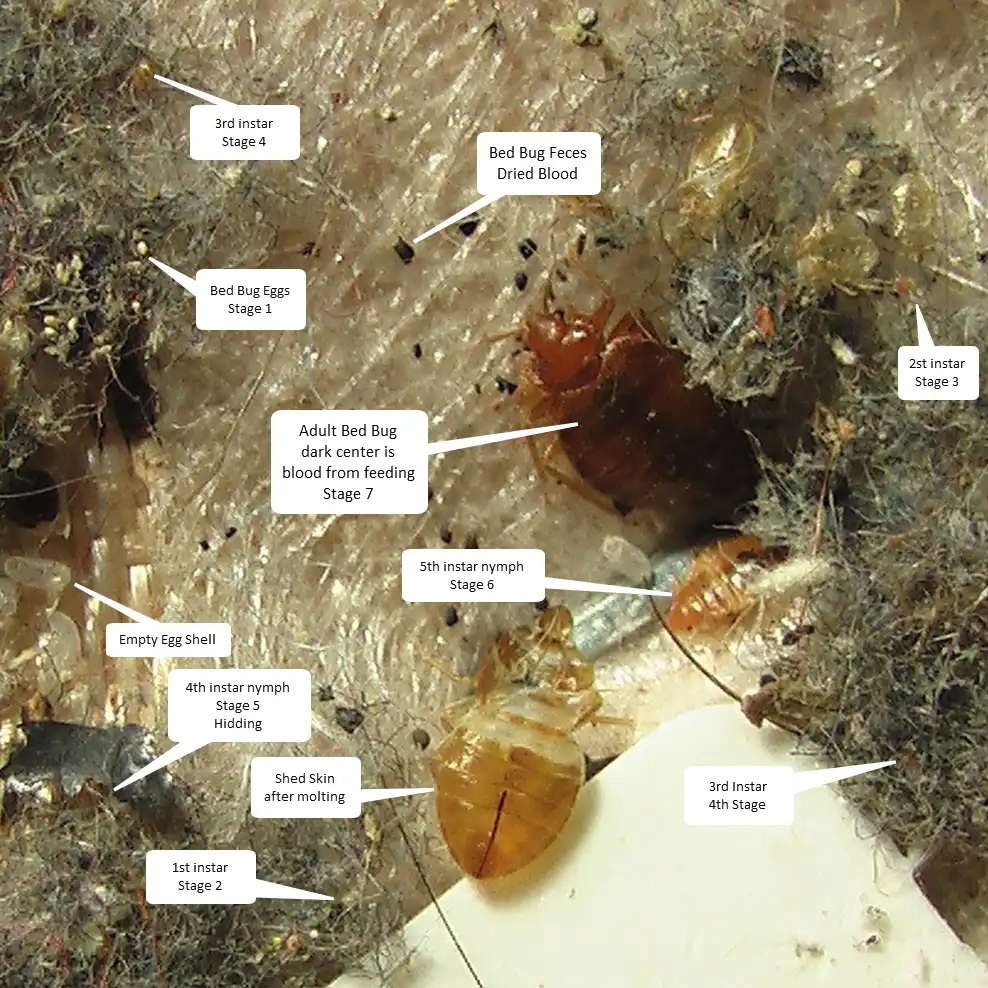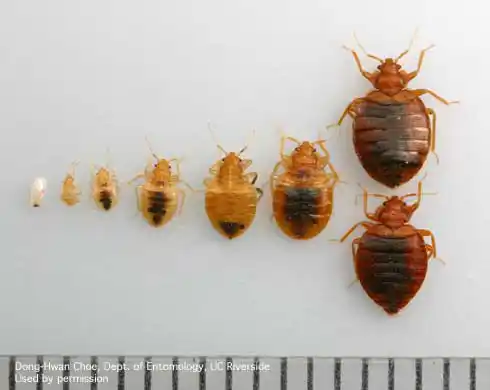Bed Bug Life Cycle
The bed bug life cycle typically takes about 40 days when well-fed. The growth cycle can take longer if the food source is limited. What is disturbing is that a fully fed bed bug at Stage 7 can live up to a year without feeding on your blood! If you click on the picture to the right, you’ll see active bed bugs at all stages of their lifecycle.
7 Stages of a Bed Bug’s Life Cycle
Bed bugs (Cimex lectularius) go through several stages in their life cycle, including egg, five nymphal steps, and adult. The entire process from egg to adult can last from several weeks to several months, depending on the temperature and availability of food. Below are the different stages in the bed bug life cycle.

Photo showing the 7 stages of a bed bug life cycle
Stage 1 is the Bed Bug Egg:
Bed bug eggs are tiny, white, and oval-shaped, about the size of a pinhead (about 1mm in length). The female bed bug can lay hundreds of eggs in her lifetime, in batches of 10 to 50, usually in cracks and crevices. These eggs are coated with a sticky substance that helps them adhere to surfaces and protect them from predators.
The eggs hatch within 6 to 10 days, depending on temperature and humidity.
Stage 2 is the First instar nymph:
After hatching, the bed bugs emerge as first instar nymphs. They are tiny, usually only about 1.5 millimeters long, and are pale white or translucent. They need to feed on blood to grow and molt to the next stage.
The first instar nymph has six legs and can move around actively. It feeds on the blood of a host, usually a human, by piercing the skin and withdrawing blood through its mouthparts. After feeding, the nymph will become engorged, and its body will become more visible.
The nymph will molt and shed its skin as it grows. It will continue to molt and develop through additional instars before reaching maturity as an adult bed bug. The first instar stage usually lasts about a week, depending on temperature and food availability.
Stage 3 is the Second instar nymph:
The bed bugs become second instar nymphs after the first molt. They are slightly larger than the first instar nymphs and have a darker color.
The bed bug nymph is still relatively small at this stage, measuring about 2-3mm in length. It has six legs and is light yellow.
During the second instar stage, the bed bug nymph undergoes several molts as it grows and develops. It will shed its skin several times before reaching adulthood. With each molt, it will become darker in color and more prominent in size.
Stage 4 is the third instar nymph:
The bed bugs are even more significant at this stage and have a more distinct head and body.
By this time, the nymphs have undergone two molts, are about 3-4.5 mm long, are oval-shaped, and have flat bodies. They are usually light brown or tan but can appear darker if recently fed on blood. This is because their mouthparts are designed for piercing the skin of their host and sucking blood. In addition, they become increasingly mobile and can crawl long distances to find a blood meal. They are also more resistant to starvation than earlier instars and can survive several months without feeding.
This is the last stage before the insect reaches adulthood and can reproduce.
Stage 5 is the Fourth instar nymph:
The fourth instar bed bug nymph is a developmental stage of the bed bug (Cimex lectularius) that occurs after the third instar and before the fifth and final instar. The nymphs have undergone three molts and are about 4.5-5.5 mm long at this stage.
Fourth-instar bed bug nymphs are similar in appearance to third-instar nymphs but are slightly larger and more developed. However, they are still oval-shaped with a flat body, and their color ranges from light brown to reddish-brown, depending on whether they have recently been fed.
During the fourth instar stage, bed bug nymphs continue to feed on blood and grow in size. They are also more likely to move around and explore their surroundings as they prepare for the final molt into adulthood.
Stage 6 is referred to as the Fifth instar nymph:
In the final nymphal stage before adulthood, fifth-instar nymphs are similar in appearance to adult bed bugs but smaller in size.
The fifth instar is the final nymphal stage of the bed bug (Cimex lectularius) before it becomes an adult. At this stage, the bed bug nymph has undergone several molts and is about 4.5mm to 5mm long.
It has a flat, oval-shaped body that is reddish-brown. The nymph has six legs and two antennae, shorter than an adult bed bug. Its body is segmented, and it has small, wing-like structures on its back that are not fully developed (bed bugs can not fly).
Like all bed bug nymphs, the fifth instar requires a blood meal to molt into adulthood.
Stage 7, the final stage:
After the fifth and final molt, the bed bug becomes an adult. Adult bed bugs are reddish-brown and about the size of an apple seed. They are fully developed and able to mate and reproduce.
They have a flat, oval-shaped body and are reddish-brown. Adults have six legs and two antennae, covering their bodies with tiny hairs.
Adult bed bugs feed on the blood of humans and animals and are usually active at night when their hosts sleep. They can live for several months without feeding but typically feed every 5-10 days. An adult bed bug can produce eight eggs per time and as many as 500 eggs during her lifetime! Studies show that an adult male can live up to a year without blood at 50F and only a month at 80F, concluding that when starved, they die faster in warmer temperatures [based on a study by Mac Dubbed Gobs].
One way to distinguish adult bed bugs from other similar insects is by their characteristic biting behavior. Bed bugs typically bite in a line or cluster pattern, and their bites can cause red, itchy welts on the skin.
Shown below is a picture from Dong-Hwan Choe at University of California Statewide Integrated Pest Management Program on bed bugs the bed bug at different stages of development (Egg, 5 nymphal stages, and 2 adult bed bugs).

What do bed bugs look like in different environments? Check out pictures submitted by our visitors over the last decade.